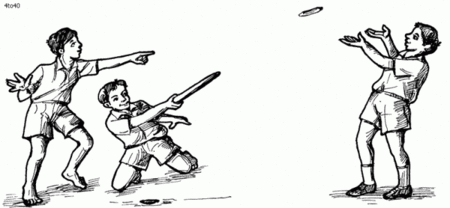
Dandi Biyo is played by two or more players. The wooden pin is laid across a four-inch deep hole in the ground. One player puts one end of the stick inside the hole and holds the other end. The player jerks the stick against the pin to launch the pin into the air while other players called 'fielders' try to catch the pin. If one of the fielders catch the pin in the air, the turn is over and the catcher takes the stick. If the pin instead hits the ground, that player plays to score. One of the fielders then throws the pin into the hole while the player tries to hit and throw the pin away. If the pin goes into the hole, the player's turn is over and the points accumulated by the player automatically becomes zero. If the pin doesn't go into the hole, the player plays to score by hitting the pin at one end by the stick. In another version of the game, a circular boundary of about one meter diameter is drawn on the ground. The player throws the pin into the circle from a distance of about two meters. If the pin lies within the circle the player continues to play and score.
The game was mostly played by Nepali youths and was very popular between 1980's and 1990's when modern toys and games were not available.
Dandi Biyo is one of many such games that were locally developed in the rural areas reflecting use of local tools and techniques. In the context of modern games, Dandi Biyo is very close to Cricket. The player can be compared to the "batsman" and the other players to the "fielders".
No comments:
Post a Comment